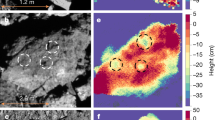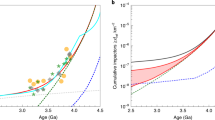Abstract
Analysis of the large number of high-velocity impact craters found on surfaces of the Solar Maximum Mission spacecraft is providing an unprecedented opportunity to measure the near-Earth meteoroid flux over a wide range of particle sizes. Zook1 and Schramm et al.2 have reported size frequencies and compositions for particles that produced 40–520-µm penetration holes in the multi-layer plastic thermal insulation blanket from ‘Solar Max’. Here we report the results of analysis of 331 craters in the 0.09–250 µm size range, found in the solid aluminium of the thermal control louvers. By elemental analysis of particle residue in the craters and scanning electron microscope imaging, we were able to distinguish impacts by natural meteoroids from those of orbital spacecraft debris, and directly determine the time-averaged flux and size distribution of both particle types over the mass range 10−13–10−7 g. The most common natural meteoroid craters contain residue that has chondritic elemental composition, while the debris craters contain a variety of residue types including paint. For 10−12 g particles the debris flux exceeds the natural meteroid flux by two orders of magnitude, but at 10−8 g the fluxes are similar.
This is a preview of subscription content, access via your institution
Access options
Subscribe to this journal
Receive 51 print issues and online access
$199.00 per year
only $3.90 per issue
Buy this article
- Purchase on Springer Link
- Instant access to full article PDF
Prices may be subject to local taxes which are calculated during checkout
Similar content being viewed by others
References
Zook, H. A. Proc. SMRM Degradation Study Workshop, 247–263 (NASA, Greenbelt, 1985).
Schramm, L. S., McKay, D. S., Zook, H. A. & Robinson, G. A. Proc. lunar planet. Sci. Conf. 16, 434–435 (1985).
Fechtig, H., Grün, E. & Kissel, J. in Cosmic Dust (ed. McDonnell, J. A. M.) 607–664 (Wiley, Chichester, 1978).
Brownlee, D. E. A. Rev. Earch planet. Sci. 13, 147–173 (1985).
Horz, F., Fechtig, H., Janicke, J. & Schneider, E. Proc. lunar planet. Sci. Conf. 14, B353–B363 (1983).
Pailer, N. & Grün, E. Planet. Space Sci. 28, 321–331 (1980).
Grün, E., Zook, H. A., Fechtig, H. & Giese, R. H. Icarus 62, 244–272 (1985).
Zook, H. A., Lange, G., Grün, E. & Fechtig, H. Proc. lunar planet. Sci. Conf. 15, 965–966 (1984).
Clanton, U. S., Zook, H. A. & Schultz, R. A. Proc. lunar planet. Sci. Conf. 11,2261–2273 (1980).
McDonnell, J. A. M., Carey, W. C. & Dixon, D. G. Nature 309, 237–240 (1984).
Naumann, R. J. NASA tech Doc. No. 3717 (1966).
Brownlee, D. E., Tomandl, D. A., Hodge, P. W. & Horz, F. Nature 252, 667–669 (1974).
McDonnell, J. A. M., Berg, O.E. & Richardson, F. F. Planet. Space Sci. 23, 205–214 (1975).
Hoffman, H.-J., Fechtig, H., Grün, E. & Kissel, J. Planet. Space Sci. 23, 215–224; 985–991 (1975).
McDonnell, J. A. M. in Cosmic Dust (ed. McDonnell, J. A. M.) 337–426 (Wiley, Chichester, 1978).
Author information
Authors and Affiliations
Rights and permissions
About this article
Cite this article
Laurance, M., Brownlee, D. The flux of meteoroids and orbital space debris striking satellites in low Earth orbit. Nature 323, 136–138 (1986). https://doi.org/10.1038/323136a0
Received:
Accepted:
Issue Date:
DOI: https://doi.org/10.1038/323136a0
This article is cited by
-
Effects of Tow Parameters on Dynamic Behaviors of Beam-type Orbital Debris
The Journal of the Astronautical Sciences (2022)
-
Demonstrating a new technology for space debris removal using a bi-directional plasma thruster
Scientific Reports (2018)
-
Microstructural phenomena associated with micrometeoroid impact craters in aluminum and stainless steel
Journal of Failure Analysis and Prevention (2004)
-
Intermediate impact factors
Nature (2002)
Comments
By submitting a comment you agree to abide by our Terms and Community Guidelines. If you find something abusive or that does not comply with our terms or guidelines please flag it as inappropriate.



